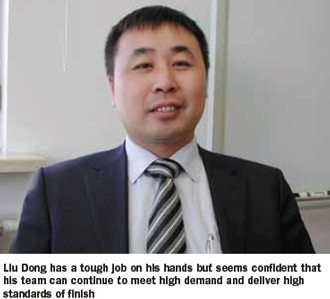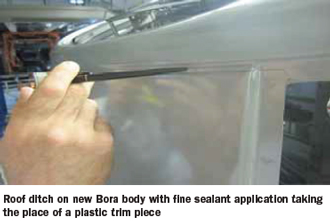
One of the busiest paintshops in the world has to not only keep pace with extraordinary demand, but also to constantly upgrade its facilities to be greener and leaner
For a man with possibly the biggest job in automotive paintshop, Liu Dong seems very relaxed when we meet in his comfortable airy office at the FAW-VW Changchun plant. At a nearby hotel, two of the world’s largest paint equipment providers are presenting their proposals to VW paintshop managers, to win a contract to re-fit Dong’s No 1 paintshop but he dismisses the gravity of this: “It is just a re-fit, to bring the old number one paintshop up to better efficiency and more modern environmental standards, my team can take care of the bidding and the contract, no problem.”
The size of his remit at Volkswagen might seem at odds with his calm demeanour, Dong has a challenging task; to continue painting up to 2500 vehicles a day at FAW Volkswagen’s giant Changchun plant in Jilin Province while upgrading the paintshops to meet new quality, cost and environmental standards. He is also responsible for paintshop planning and implementation at the new Chengdu plant, some four hours flight time away, in Sichuan Province.
 APS was allowed a free run of the main plant’s No. 2 paintshop. Building work on this facility started in 2004 and start of production was in 2005. About 1000 people work three shifts in No. 2, with 100 of those employed in maintenance. Indeed, maintenance is a major preoccupation for Liu Dong; with such a throughput of bodies and the high quality standards demanded by Chinese VW and Audi buyers, cleanliness and smooth running of the lines is vital.
APS was allowed a free run of the main plant’s No. 2 paintshop. Building work on this facility started in 2004 and start of production was in 2005. About 1000 people work three shifts in No. 2, with 100 of those employed in maintenance. Indeed, maintenance is a major preoccupation for Liu Dong; with such a throughput of bodies and the high quality standards demanded by Chinese VW and Audi buyers, cleanliness and smooth running of the lines is vital.
Bodies come in to the e-coat area and are mounted on an Eisenmann VarioShuttle system for PT and ED; 27 VarioShuttles are used in pre-treatment (PT) and 17 in electrodeposition (ED). Dong tells me that sheer volume of work requires him to keep one complete spare VarioShuttle ‘arm’ as a clean ‘float’ part – one arm is always clean and ready to be exchanged for a ‘dirty’ one, on a daily basis.
Indeed maintenance requires one production-free day every two weeks, when the shuttle system is fully cleaned and serviced; regular cleaning (after each ‘round’ of e-coating) is done by dipping the shuttle in a tank of a BASF-sourced mild acid cleaner. E-coat media is filtered through Hayward filters (now part of Eaton Corporation) and PT chemicals are sourced from Chemetall.
Volkswagen started to cooperate with First Automobile Works (FAW) in Changchun in 1988, planning the production of the Audi 100 under license.
Today, over 9,800 employees work at FAW Volkswagen Automotive Company, Ltd., a joint operation between FAW, Volkswagen and Audi. Following plant expansion in 2004 (Car Plant 2 in Changchun), the company makes up to 600,000 vehicles per year.
FAW-VW currently produces engines, gearboxes and Volkswagen models Magotan, Volkswagen CC, Sagitar, Golf, Golf GTI, New Bora and Jetta A2 at two plants, in Changchun and Chengdu. The Audi models produced include the A6 L (long-wheel-base) and A4 L (long-wheel-base) as well as the Q5.
 On the new Bora model, the company has moved to a sealing solution that has been seen in Europe for some time; a very carefully controlled amount of a Henkel sealer is run into the roof ‘ditch’ – the join between the roof panel and the body side – using a Fanuc robot and a Graco pump system.
On the new Bora model, the company has moved to a sealing solution that has been seen in Europe for some time; a very carefully controlled amount of a Henkel sealer is run into the roof ‘ditch’ – the join between the roof panel and the body side – using a Fanuc robot and a Graco pump system.
This application was designed and built by a Swiss supplier, EFTEC. The Bora body then goes under an infrared heat lamp station to cure the sealer before other seam sealers and underbody coatings are cured in the next oven stage. The Bora bodies are identified by a Siemens RFID tag and sensor system and so are stopped under the infrared lamp station. Underbody coating is fully automated in three stations, with two robots each, using four vision system cameras in each station. There are some places on the bodies that the robots cannot reach and in a last station, seam sealer is applied manually by brush.
Insulation for sound deadening and anti-drumming is magnetic for vertical panels and is cured in the usual way, in the sealer oven stage.
SDS: You offer a large colour palette, how many different primers do you use to accommodate this and how do you manage the primer supply?
LD: Yes, we have 21 different top coat colours available for Volkswagen and Audi models, of these 17 or 18 are metallic colours, the most popular being silver and metallic black. Metallic paint is a popular option even on the more ‘base’ models such as Jetta. For this, we are using four different coloured primers with a cartridge system to switch between them quickly.
SDS: And are many of the panels used here in China zinc coated steel?
LD: Some of the Volkswagen Jetta range is made with plain mild steel but the other VWs and all the Audis have either zinc coated steel or aluminium panels.
SDS: What is the latest development here at Changchun?
LD: In July 2011, we started a new a new pre-treatment and e-coat line in No. 1 plant. This line came from Dürr.
SDS: And what is so new about it?
LD: It uses the RoDip system to fully rotate the bodies and has a fi ve-minute e-coat process. Also, we can now accommodate the Q5 and A6 aluminium body panels better as we have extended the oven line to give a 20-minute bake time.
SDS: Many people think china is very good value for painting by hand but for quality and for speed automation must take over. What is your experience here?
LD: For the exterior, all painting is automated but inside we use manual here in Changchun. In Chengdu we will use robots for all painting operations. This is mainly for quality and speed but also labour cost has gone up in China over the last few years and manual spraying is not so cost-effective any more.
SDS: So at the moment here when you say you paint inside manually do you mean just door shuts or the whole interior and underbonnet?
LD: At present, the whole interior and underbonnet but in the future, in 2 or 3 years time we will install robots for total interior painting, at No. 1 plant and at No. 2.
SDS: Who are your paint suppliers here?
LD: We work together with PPG and Dupont and BASF.
SDS: And for the chemical side?
LD: This varies; in car plant No. 1 we use Dupont e-coat, in car plant No. 1 BASF, in Chengdu, car plant No. 3 we use PPG e-coat. Using this approach, we can compare quality, cost and effi ciency. Also if one supplier had a supply had a problem we can swap over straight away, as there is no difference in the process.
SDS: And this is the same for your base coat and top coat, one supplier in one plant, one in another and so on?
LD: It is more a of a mixture, for example in car plant No. 1 we have some colour from Dupont, some colour from BASF; each car plant has a mix of suppliers. This is because we find some colours are better from certain suppliers and we want the flexibility to be able to change from one to another.
SDS: I notice you don’t paint any plastic parts, how was this decided?
LD: It’s a decision of the whole group Volkswagen and Audi. For example, our bumpers are painted by the local supplier in Changchun, colour matched using spectrophotometer technology.
SDS: The cleaning of your equipment, are you doing this yourself or do you have a service company also doing cleaning?
LD: We have a contract with supplier company, they carry out all the cleaning work in the paintshop. We have found that using a supplier for cleaning is cheaper plus they have specialised knowledge of cleaning. For the waste management of sludge we use Remondis.
SDS: And for the emissions, which system are you using for cleaning the exhaust air?
LD: We have a wet scrubber. But this is very old so in Chengdu we use a dry scrubber system.
SDS: When you improve the paintshops in No. 1 and No. 2 will you move to dry scrubber technology?
LD: This is very difficult because they are very old lines. We have plan to first disassemble the old lines to make space by ‘juggling’ space: taking out an old primer line and putting a new top coat and clear coat line in its place. Then we will use new fully automated technology, with dry scrubber.
SDS: Can you run with one stopped and the other one running or do you have to take the lines out one at a time and keep running all the time?
LD: Yes, we must keep as many lines running as possible as demand is so high. Basically we need one extra line available at all times, to use as a ‘spare’ while we re-fit other lines.
SDS: If you are using wet-on-wet system, you can take out at least one oven/curing stage. Is this in your plans?
LD: We have heard of the three-wet process; at the moment Audi, in Ingolstadt and Györ, have tried this process but it has not been taken up by them as far as I know.
SDS: What about the primerless system?
LD: We are using this system in our Car Plant 3 in Chengdu; we increase the basecoat thickness accordingly. We use this on A- and B-segment vehicles like the Jetta, generally the more non-premium segment cars.

All bodies are hand spot sanded and any dust is manually blown off with compressed air and wipers before underbonnet and door shuts are primed manually; exterior primer is applied by Fanuc robot. Cabin interiors are not primed; this is to save cost and Volkswagen feels the quality of e-coat is now so good that interior priming is unnecessary.
Topcoat is batched into seven to eight car colour runs and the door shuts and interiors, pillars and underbonnet are sprayed manually before robots paint the first coat electrostatically and the second coat with air feed for metallics. Measurement of paint thickness and quality is manual and carried out with three different devices; BYK Gardner colour spectrophotometers for colour checking and its wave-scan meters for orange peel and DOI measurement, and Hynix meters for paint thickness.



































